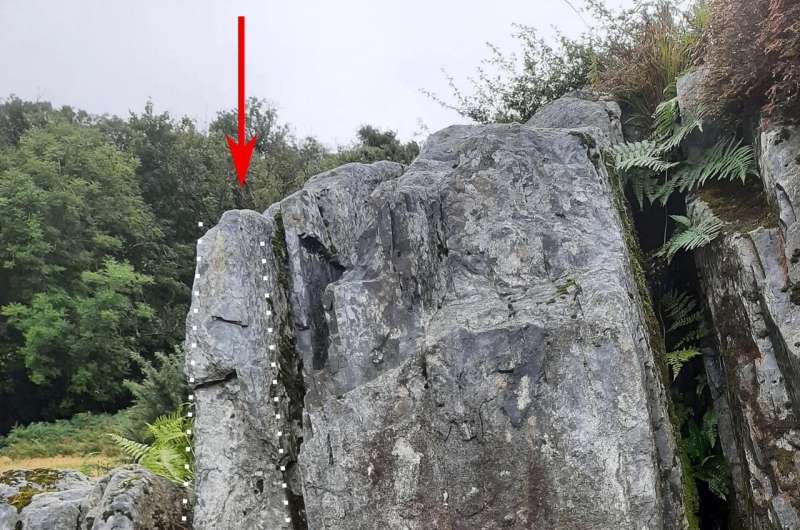Science
New Study Confirms Humans Transported Stonehenge Bluestones

New research led by Aberystwyth University reveals that ancient Neolithic people, rather than glacial processes, transported the iconic bluestones to Stonehenge. The study focuses on the “Newall boulder,” a small fragment believed to have come from Craig Rhos-y-Felin in Wales, located over 200 kilometers away from the famous monument.
Stonehenge, while renowned for its massive standing stones, also features smaller blue-hued megaliths known as bluestones. The origins and transportation methods of these stones have fueled debate among archaeologists for years. Some experts suggested that glaciers may have carried the stones to Salisbury Plain, while others argued for deliberate human transport. The ongoing investigation into the Newall boulder, excavated in 1924, has become a critical point of discussion in this debate.
In the study titled “The enigmatic ‘Newall boulder’ excavated at Stonehenge in 1924: New data and correcting the record,” published in the Journal of Archaeological Science: Reports, researchers employed advanced mineralogical, petrographic, and geochemical analyses. The Newall boulder, measuring 22 × 15 × 10 cm, was recovered during excavations led by Lt-Col Hawley and later analyzed by various institutions.
Petrographic analysis confirmed that the boulder matches Rhyolite Group C from Craig Rhos-y-Felin. This correlation was further supported by geochemical data, which showed that the Newall boulder’s characteristics align closely with the rhyolite pillars at its source. Notably, no glacial striations were detected on the surface, and any signs of weathering were attributed to environmental exposure after the stone’s breakage.
Field investigations conducted across Salisbury Plain yielded no evidence of glacial deposits or erratics—rocks transported by glacial activity. This absence further undermines the glacial transport theory. Angular fragments found near Stonehenge displayed characteristics consistent with deliberate human shaping rather than natural erosion.
The researchers concluded that the Newall boulder is a piece of Craig Rhos-y-Felin rhyolite, likely broken from a larger monolith, such as Stone 32d. Their findings strongly support the theory that all bluestones at Stonehenge were transported by Neolithic people, discrediting the notion of glacial movement.
This pivotal study not only clarifies the origins of the Newall boulder but also reinforces the argument that the construction of Stonehenge was a significant human endeavor. The research was led by Richard E. Bevins and has been reviewed for credibility by professionals including Andrew Zinin, ensuring its reliability as a scholarly source.
As discussions about Stonehenge continue, this new evidence contributes to a deeper understanding of the monumental site’s history and the capabilities of its ancient builders. The research highlights the importance of human agency in shaping our archaeological heritage, emphasizing that the creation of such structures was a remarkable feat of engineering and organization by Neolithic societies.

-

 Lifestyle5 months ago
Lifestyle5 months agoLibraries Challenge Rising E-Book Costs Amid Growing Demand
-

 Sports5 months ago
Sports5 months agoTyreek Hill Responds to Tua Tagovailoa’s Comments on Team Dynamics
-

 Sports5 months ago
Sports5 months agoLiverpool Secures Agreement to Sign Young Striker Will Wright
-

 Lifestyle5 months ago
Lifestyle5 months agoSave Your Split Tomatoes: Expert Tips for Gardeners
-

 Lifestyle5 months ago
Lifestyle5 months agoPrincess Beatrice’s Daughter Athena Joins Siblings at London Parade
-

 Science4 months ago
Science4 months agoSan Francisco Hosts Unique Contest to Identify “Performative Males”
-

 World5 months ago
World5 months agoWinter Storms Lash New South Wales with Snow, Flood Risks
-

 Science5 months ago
Science5 months agoTrump Administration Moves to Repeal Key Climate Regulation
-

 Business5 months ago
Business5 months agoSoFi Technologies Shares Slip 2% Following Insider Stock Sale
-

 Science5 months ago
Science5 months agoNew Tool Reveals Link Between Horse Coat Condition and Parasites
-

 Sports5 months ago
Sports5 months agoElon Musk Sculpture Travels From Utah to Yosemite National Park
-

 Science5 months ago
Science5 months agoTom Lehrer, Pioneering Satirist and Musician, Dies at 97








